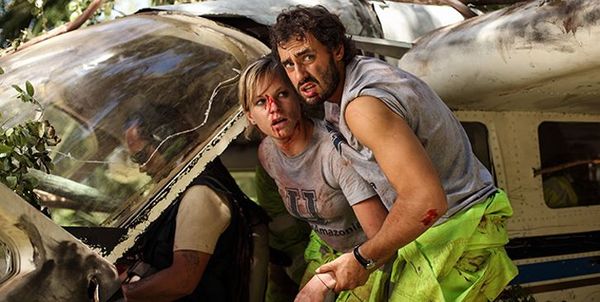Eye For Film >> Movies >> The Green Inferno (2013) Film Review
The Green Inferno
Reviewed by: Andrew Robertson

This is the latest installment of Eli Roth's continuing war on foreign travel, a film that manages to simultaneously be a loving and ludic homage to the cannibal horror genre and a massively problematic trample through gender studies and post-colonialism.
There's a character whose sole function seems to be to be our protagonist's bitchy flatmate, who delivers a line near the start that later seems like exculpatory exposition - "I can say that, I'm Jewish". The villagers are played by genuine natives, but they are painted red, and black, and yellow. The final girl is painted white at one point, but there's a chance that this is risky playfulness. To paraphrase a conversation in the small plane that contributes much to the film, "just because he's Latin and has money doesn't mean that he's a drug dealer". "I didn't say he was a drug dealer." There are expectations here, and some subversions, but also a poop joke. A lecture on female genital mutilation serves as both an opportunity for exposition and a portent. Chekhov's mantelpiece is pretty well stocked here, it's certainly well constructed in its depiction of the progression towards "final girl", but there are problems everywhere.

From the moto-taxi called "Rocky IV" to the guide to the cannibal horror genre that comes up in the credits, it's full of references to other films. Inviting such comparisons can be dangerous, for a few reasons. To give but two examples, Roth has used CGI for a few moments of animal action: the first is a portentous jaguar, which manages to be less convincing than the similarly composited Tasmanian tiger in The Hunter, despite the massive surplus of footage and access to the former; the second is a giant ant attack that is scarcely more credible than the one in Indiana Jones And The Crystal Skull.
There's the sexual, racial, and campus politics - there's the discussion of 'trending' and the inclusion of the main cast's twitter handles in the credits - there's the weird disconnect between activists disappearing after an ostensible global media event and a lack of a search - all this before the interruption in the credits that would make it clear there's intent to produce a sequel, even if it wasn't made explicit in its festival catalogue listing. Roth was tweeting with a hashtag for the film before its screening at the Edinburgh International Film Festival, and perhaps that's the current state of the art in viral marketing but it's got the whiff of trying too hard.
The credits are interrupted by set-up for a sequel, a move that's declassé even if it's as simple as "James Bond Will Return" but is here packaged as a satellite image that owes more to Enemy Of The State than optical physics and an accompanying telephone call.
There are moments where its difficult to seperate awareness of the process of making films from watching a film. When Magneto and Xavier shake hands in Days of Future Past the complete absence of identifying features other than colour coded sleeves and leather gloves makes one wonder if it was Sirs McKellen and Stewart, or stand-ins, and some of the tight shots and staging in The Green Inferno suggest the sound-stage and not the jungle. Jungle advisedly, not rain-forest, because the characterisation of this verdant terra incognito is decidedly old-fashioned, like a racist grandpa who insists on holding the door for ladies. It's got some strengths - fair's fair - while it's clear the aircraft interiors were filmed some distance from the skies the plane was occupying it does afford a dizzying and nauseating crash.
Conspiracies abound, and collusion, there's post-facto re-mythologising of native peoples that would put meat on the bones of almost any cultural studies essay, and a bad, bad, bad guy, and bluntly, there is so much going on that perhaps your reviewer has been distracted from the wood by the trees.
It's a movie, with cannibals, directed by Eli Roth. If you want a movie where "I'm a vegan" is nearly a punch-line and if you won't question the presence of chickens, pigs, and cattle being kept by an Amazonian tribe who haven't had contact with modernity, then The Green Inferno will do. If that's enough then that's fair enough, but this is a popular genre for re-imagining, and more cleverly than here.
Reviewed on: 19 Jun 2014

















